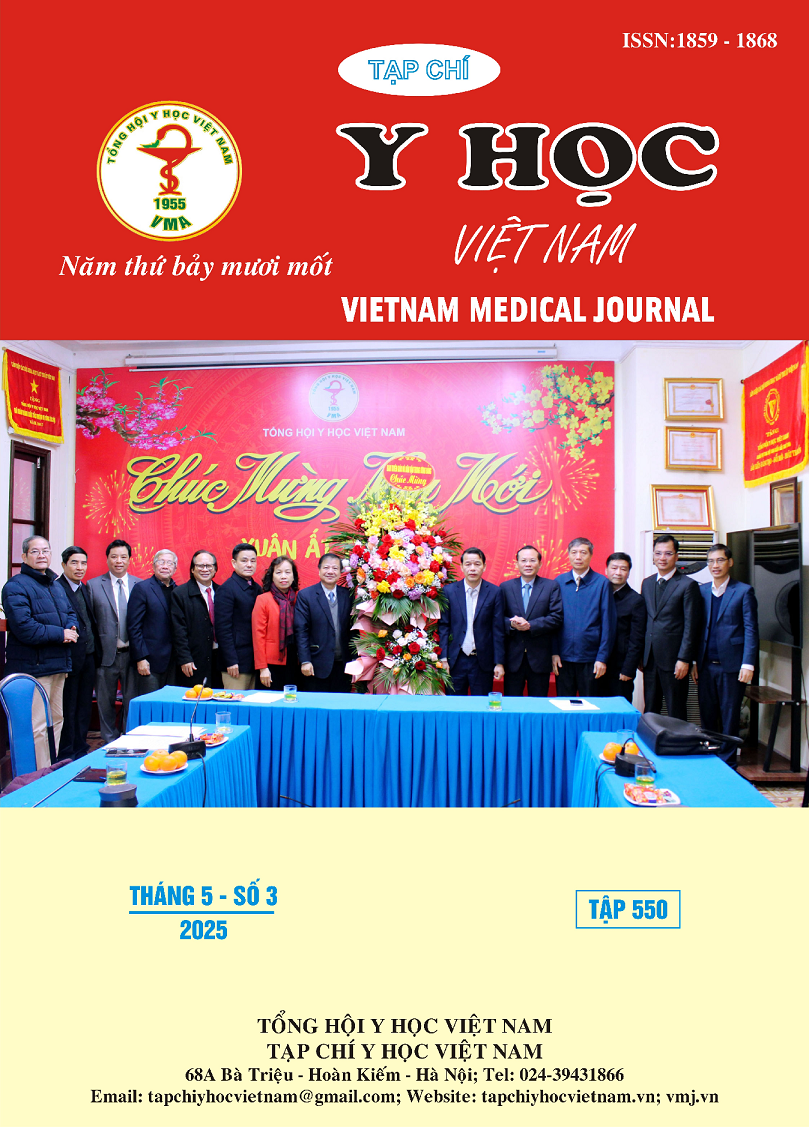EVALUATION OF IMPLANT PLACEMENT RESULTS WITH TENT-POLE TECHNIQUE IN MOLAR AREA USING A MIXTURE OF MELATONIN AND HYALURONIC ACID
Main Article Content
Abstract
Background: Implant placement using the tent-pole technique increases vertical soft tissue thickness but may cause bone loss of up to 0.51 mm. The use of a hyaluronic acid and melatonin mixture significantly reduces bone resorption and enhances bone density during surgical procedures. Objective: This study aims to evaluate the effectiveness of a melatonin and hyaluronic acid mixture in the tent-pole technique for implant placement in the mandibular molar region. Materials and Methods: A total of 30 patients were selected to participate in this study. All patients underwent implant placement at the Can Tho University of Medicine and Pharmacy Hospital from April 2023 to February 2025. Clinical parameters including vertical soft tissue thickness, crestal bone loss, healing index, and peri-implant aesthetics were monitored. Results: The mean postoperative vertical soft tissue thickness was 3.9 ± 0.8 mm. The proportion of implants with bone loss ≤ 0.2 mm remained high (83.3% at 7 months), while only 6.7% of implants exhibited bone loss >0.5 mm. No cases of bone loss exceeding 1 mm were recorded. The mean pink esthetic score was 10.7 ± 2.1. No cases of gingivitis or peri-implantitis were observed after prosthetic restoration. Conclusion: The tent-pole technique combined with a melatonin and hyaluronic acid mixture has been proven to be safe and holds great potential for increasing soft tissue thickness and controlling peri-implant bone loss in the mandibular molar region.
Article Details
Keywords
tent-pole technique, melatonin, hyaluronic acid, crestal bone loss, vertical soft tissue thickness.
References
2. Allegra M, Reiter RJ, Tan DX, et al. The chemistry of melatonin's interaction with reactive species. Journal of pineal research. 2003; 34(1), pp. 1-10. doi: 10.1034/j.1600-079X.2003.02112.x
3. de Araújo Nobre M, Cintra N, and Maló P. Peri‐implant maintenance of immediate function implants: a pilot study comparing hyaluronic acid and chlorhexidine. International journal of dental hygiene. 2007; 5(2), pp. 87-94. doi: 10.1111/j.1601-5037.2007.00239.x
4. Nasr A, Shoeib M, Darhous M, et al. The Effect of Melatonin and Hyaluronic Acid Mixture on Hard Tissue Dimensional Changes Around Immediate Post-Extraction Implants. Egyptian Dental Journal. 2022; 68(1), pp. 565-577. doi: 10.21608/edj.2022.110319.1898
5. Hamzani Y and Chaushu G. Evaluation of early wound healing scales/indexes in oral surgery: A literature review. Clinical implant dentistry and related research. 2018; 20(6), pp. 1030-1035. doi: 10.1111/cid.12680
6. Fürhauser R, Florescu D, Benesch T, et al. Evaluation of soft tissue around single‐tooth implant crowns: the pink esthetic score. Clinical oral implants research. 2005; 16(6), pp. 639-644. doi: 10.1111/j.1600-0501.2005.01193.x
7. Casale M, Moffa A, Vella P, et al. Hyaluronic acid: Perspectives in dentistry. A systematic review. International journal of immunopathology and pharmacology. 2016; 29(4), pp. 572-582. doi: 10.1177/03946320166529
8. Misch CE, Perel ML, Wang H-L, et al. Implant success, survival, and failure: the International Congress of Oral Implantologists (ICOI) pisa consensus conference. Implant dentistry. 2008; 17(1), pp. 5-15. doi: 10.1097/ID.0b013e3181676059


